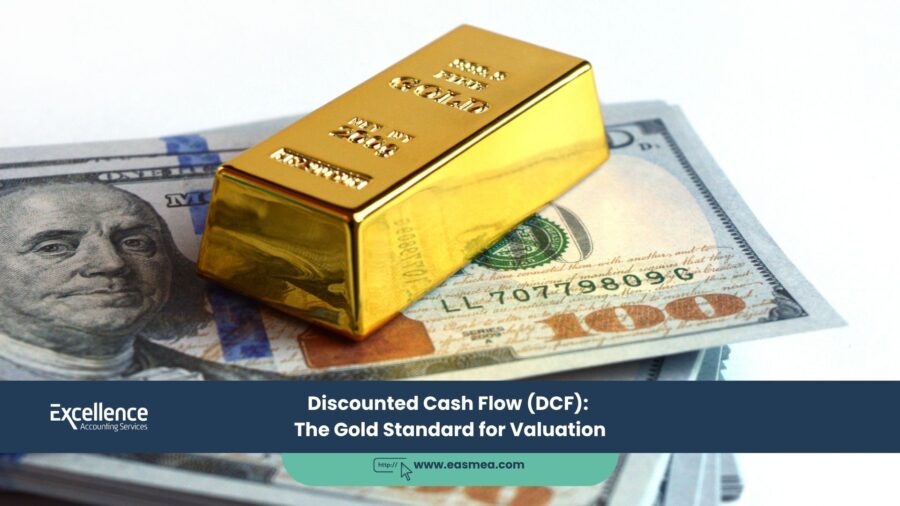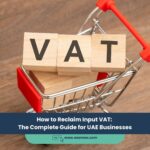Discounted Cash Flow (DCF): The Gold Standard for Business Valuation
In the world of business finance, determining a company’s true worth is both an art and a science. While various methods exist, from simple market multiples to asset-based calculations, one method stands above the rest in its rigor, detail, and fundamental logic: the Discounted Cash Flow (DCF) analysis. For serious investors, business owners, and financial professionals in the UAE, understanding the DCF method is no longer optional—it’s essential for making sound strategic decisions in a market transformed by new economic realities like Corporate Tax.
At its core, the DCF method is built on a simple but powerful premise: a business is worth the sum of all the cash it can generate for its investors in the future, adjusted for the time value of money. It’s considered the “gold standard” because it values a company based on its intrinsic ability to generate cash, rather than on subjective market sentiment or simplistic comparisons. It forces a deep, forward-looking analysis of a company’s operations, risks, and growth potential.
This comprehensive guide will demystify the DCF valuation method. We will break down its three core components, walk through the step-by-step process, and explain how the introduction of UAE Corporate Tax has fundamentally changed the inputs and outcomes of this critical valuation tool.
Key Takeaways
- DCF Measures Intrinsic Value: It calculates a company’s value based on its projected future cash flows, providing a fundamental measure of worth independent of market hype.
- Based on the Time Value of Money: The core principle is that a dirham today is worth more than a dirham tomorrow. Future cash flows are “discounted” back to their present value.
- Three Core Components: A DCF valuation is built on forecasting Free Cash Flow (FCF), determining an appropriate Discount Rate (WACC), and estimating the Terminal Value (TV).
- Corporate Tax is a Critical Input: The UAE’s 9% Corporate Tax directly reduces future cash flows and affects the discount rate, making it a crucial variable in all modern DCF models.
- “Garbage In, Garbage Out”: The accuracy of a DCF valuation is highly dependent on the quality and reasonableness of the assumptions used in the forecast.
Deconstructing the DCF Model: The 3 Core Components
A credible DCF valuation is not a single calculation but the culmination of three detailed analyses. Mastering these components is the key to mastering the DCF method.
Component 1: Forecasting Free Cash Flow (FCF)
This is the engine of the valuation. Free Cash Flow to the Firm (FCFF) represents the cash generated by the business that is available to all its capital providers, both debt and equity holders. It’s the lifeblood of the company, calculated *after* accounting for all operating costs and necessary reinvestments in the business.
A common way to calculate it is:
FCFF = NOPAT + D&A – Capital Expenditures – Change in Net Working Capital
- NOPAT (Net Operating Profit After Tax): This is the company’s operating profit (EBIT) adjusted for taxes. With UAE Corporate Tax, this is now calculated as `EBIT * (1 – 0.09)`.
- D&A (Depreciation & Amortization): These are non-cash expenses that are added back.
- Capital Expenditures (CapEx): The cash spent on acquiring or maintaining long-term assets like machinery and buildings.
- Change in Net Working Capital: The investment needed to fund short-term operational assets like inventory and accounts receivable.
Component 2: The Discount Rate (WACC)
Since a dirham in the future is worth less than a dirham today, we need a rate to “discount” those future cash flows back to their present value. This rate is the Weighted Average Cost of Capital (WACC). It represents the blended average rate of return required by the company’s investors (both shareholders and lenders) to compensate them for the risk they are taking.
The formula is:
WACC = (Cost of Equity × % Equity) + (Cost of Debt × % Debt × (1 – Tax Rate))
The introduction of UAE Corporate Tax has a direct impact here. Because interest payments on debt are a deductible expense, they create a “tax shield” that lowers the effective cost of debt. This is reflected in the `(1 – Tax Rate)` part of the formula.
Component 3: The Terminal Value (TV)
It’s impractical to forecast a company’s cash flows forever. Typically, a DCF model projects detailed cash flows for a 5 or 10-year period. The Terminal Value is a calculation that represents the entire value of the business from the end of the forecast period into perpetuity. This can often account for over 50% of the total valuation.
There are two primary methods to calculate it:
- Perpetuity Growth Method: Assumes the company’s cash flow will grow at a stable, sustainable rate (like GDP growth or inflation) forever. The formula is `(Final Year FCF * (1 + g)) / (WACC – g)`.
- Exit Multiple Method: Assumes the business will be sold at the end of the forecast period for a multiple of its earnings (e.g., 8x EBITDA), based on what similar companies are trading at.
The DCF Process in 5 Steps
- Forecast Free Cash Flows: Build a detailed financial model to project the company’s FCFF for a specific period (usually 5-10 years).
- Calculate the WACC: Determine the company’s cost of equity and debt, and combine them to calculate the WACC.
- Estimate the Terminal Value: Using either the perpetuity growth or exit multiple method, calculate the value of the business beyond the forecast period.
- Discount to Present Value: Using the WACC as the discount rate, calculate the present value of each year’s projected FCF and the present value of the Terminal Value.
- Calculate Enterprise Value: Sum up all the present values of the discounted cash flows. This gives you the Enterprise Value of the business. To get to the Equity Value, you would then subtract debt and add cash.
Expert DCF Valuation Services from EAS
A credible DCF valuation requires deep financial expertise and a rigorous approach. At Excellence Accounting Services (EAS), our business valuation specialists provide robust, defensible DCF analyses for businesses across the UAE.
Our Services Include:
- Building Detailed Financial Models: We create comprehensive, assumption-driven models to forecast your company’s future free cash flows accurately.
- Calculating a Defensible WACC: We conduct the necessary research and analysis to determine an appropriate, risk-adjusted discount rate for your business.
- Incorporating UAE Corporate Tax: Our models are fully updated to reflect the impact of the new tax law on both cash flows and the cost of capital.
- Comprehensive Valuation Reports: We provide clear, detailed reports that explain our methodology and conclusions, suitable for M&A, fundraising, and strategic planning.
Frequently Asked Questions (FAQs)
DCF is an intrinsic valuation method based on a company’s specific future cash flows. A multiples valuation is a relative method that values a company by comparing it to what similar companies are worth in the market. A good valuation process often uses both: DCF to determine intrinsic value and multiples to see how that compares to the market.
Unlevered Free Cash Flow (or FCFF) is the cash flow available to *all* capital providers before considering the effects of debt (leverage). We use it to calculate the Enterprise Value (the value of the whole business). We only subtract debt at the very end of the process to arrive at the Equity Value.
It can be very difficult to use for pre-revenue startups because there is no historical data to base the cash flow projections on. The valuation becomes extremely sensitive to highly uncertain assumptions. For startups, other methods like the Venture Capital method or market comparisons are often more practical.
The perpetual growth rate ‘g’ must be a long-term, sustainable rate. It cannot be higher than the long-term growth rate of the economy in which the business operates. Typically, it is set between the long-term inflation rate (e.g., 2%) and the long-term GDP growth rate (e.g., 3-4%).
Since the DCF is so dependent on assumptions, a sensitivity analysis is crucial. It involves creating a table that shows how the final valuation changes when you alter key inputs, such as the WACC and the growth rate. This shows a range of possible values rather than a single, misleadingly precise number.
It has a significant, direct negative impact on the free cash flow projections. However, this is slightly offset by the positive impact of the tax shield on debt, which lowers the WACC. The net effect is almost always a lower valuation than in a 0% tax environment, but the exact amount depends on the company’s profitability and capital structure.
Enterprise Value is the value of the entire business operation (assets). Equity Value is the value that belongs to the shareholders. The DCF process calculates Enterprise Value first. To get to Equity Value, you use the formula: **Equity Value = Enterprise Value – Debt + Cash.**
While templates can help you understand the mechanics, a professional valuation is highly recommended. The value of a DCF is not in the template but in the quality of the assumptions. An expert can make much more credible and defensible assumptions about growth, margins, and risk, leading to a more reliable valuation.
The most common mistake is being overly optimistic with the projections. Unrealistic revenue growth or margin expansion assumptions will lead to an inflated and indefensible valuation. The principle of “garbage in, garbage out” applies perfectly to DCF analysis.
They are two sides of the same coin. The DCF valuation is built on a set of assumptions about the future. The due diligence process is the investigation you conduct to verify if those assumptions are reasonable and if there are any hidden risks that would negatively impact the projected cash flows.
Conclusion: The Ultimate Tool for Strategic Insight
While no valuation method is perfect, the Discounted Cash Flow analysis remains the gold standard for a reason. It forces a disciplined and comprehensive examination of all the factors that truly drive a business’s value: its ability to generate cash, its growth prospects, and its risk profile.
In the new corporate landscape of the UAE, mastering the principles of DCF is more than just a financial exercise; it’s a strategic necessity for any business owner who wants to understand, manage, and maximize the true intrinsic value of their enterprise.
What is Your Business Truly Worth?
Our expert valuation team can provide a clear, defensible, and tax-compliant valuation to support your most important strategic decisions.




